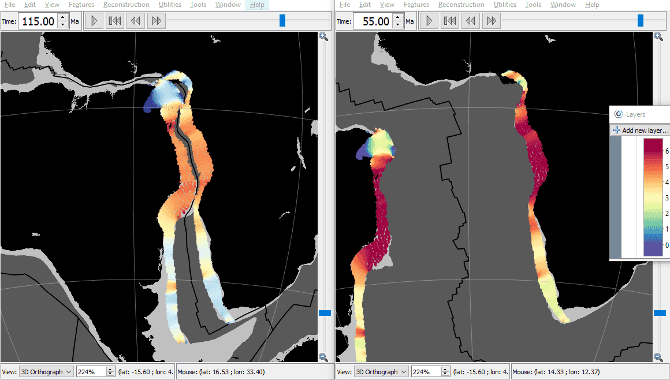GPlates 2.3 released
Download GPlates 2.3:-
Download GPlates 2.3 and compatible geodata from the Download page.
What's new in GPlates 2.3:-
- Deformation:
- Added tectonic subsidence due to crustal stretching and subsequent cooling of lithosphere.
- Numerically solves 1D temperature advection-diffusion equation over lithosphere depth at each surface point:
- Solved during and after crustal stretching.
- Initial conditions:
- Linear temperature gradient over lithosphere depth (equilibrium state).
- Zero subsidence.
- Numerically solves 1D temperature advection-diffusion equation over lithosphere depth at each surface point:
- Improved stability of crustal thinning calculations by clamping strain rate.
- Added tectonic subsidence due to crustal stretching and subsequent cooling of lithosphere.
- Rendering:
- Supports high-DPI displays (eg, Apple Retina).
- Added two new age palettes (traditional and modern) along with existing legacy.
- Tool palette on macOS now looks similar to Windows and Linux.
- Export:
- Support export of GeoJSON files.
- Added choice in general resolved topology export (in relation to sub-segments of topological line segments).
- OGR GMT exports now have dateline wrapping disabled by default (previously enabled by default).
- Layers:
- New option in yellow layer to extend rotation sequences beyond oldest times in rotation file:
- Such that reconstructed geometries are not snapped back to present day positions.
- New option in yellow layer to extend rotation sequences beyond oldest times in rotation file:
- Memory usage:
- Reduced memory usage of geometries:
- Multi-points reduced 40%.
- Polylines and polygons reduced 33%.
- Reduced rotation tree memory usage by 25%.
- Reduced memory usage of geometries:
- Build:
- Overhauled build system to use modern CMake 3.
- Create standalone binary packages within the build system (for macOS, Windows and Linux).
- Standalone recursively installs dependency libraries into package.
- Windows supports NSIS installer and ZIP archive (both standalone).
- macOS supports DMG disk image (standalone).
- Signs GPlates bundle, its internal contents and final DMG with a Developer ID certificate.
- Notarization by Apple still manually done outside build system.
- Linux supports:
- Debian package (non-standalone: system package manager installs dependencies).
- Tarball (standalone: pre-packaged dependencies).
- Library dependencies:
- Significant upgrade to Qt version 5 (from version 4).
- GPlates and pyGPlates now link to zlib (no longer require the gzip program).
- Ported Hellinger Python code to Python 3, and NumPy >= 1.12.
- C++11 is now the minimum C++ language requirement.
- GDAL 2.3 and above require it.
- CGAL 5 and above require C++14.
- Updated GPlates icon to new blue icon.
- Changed version numbering to support pre-release packaging (dev, alpha, beta, release candidate):
- Bug fixes:
- Fixed macOS scrollbar in layers window obscuring underlying layer controls.
- Fixed exporting CitcomS topological segments using a header format CitcomS is unable to pre-process:
- This resulted in missing subduction polarities, for example.
- Behaviour now matches GPlates 2.1.
- Fixed exporting CitcomS topological segments using a header format CitcomS is unable to pre-process:
- Fixed exception/crash in the following topological scenario:
- a topological polygon sub-segment is a rubber-banded resolved topological line, and
- shared by two topological polygons, and
- we're retrieving its sub-sub-segments (eg, in general resolved topology export).
- Fixed topology resolving at triple junction with rubber bands converging on a single point.
- Fixed crash when a point inside a deforming network's rigid block is not always detected as such.
- Raster fixes:
- Fixed bug where part of a raster touching dateline is stretched right across map (in 2D map views).
- Fixed incorrect clipping of high resolution floating-point rasters in map view.
- Fixed missing square sections in raster when using non-zero central meridians in map view.
- Fixed regional imported raster not getting exported with same extents.
- GPlates log file now saved to writable location when current working directory lacks write permission:
- For example, save to
C:/Users/<USER>/AppData/Local/GPlates/when GPlates installed toC:/Program Files/.
- For example, save to
- Enable writing of
.jsonfiles (not just.geojson). - Fixed PLATES rotation file sometimes having unsaved changes (immediately after loading).
- Fixed one GROT file getting saved with the contents of another GROT file.
- And also crashing when trying to save the first GROT file after unloading the second one.
- Kinematics tool:
- Angular velocity (rads/Myr) is now always positive since stage rotation pole is arbitrary,
- because can negate pole/angle pair and get same rotation, so just take absolute value.
- Fixed crash on Linux when opening a save file dialog to get project or feature collection file name.
- Fixed default user preferences not getting initialised properly on some systems.
- Fixed dateline wrapping parameter not getting used for export to OGR GMT format.
- Fixed polyline around the equator not getting intersected with small polygon crossing it.
- Fixed some zero area dateline sliver polygons giving incorrect areas (multiples of PI instead of zero).
- Fixed polygon around the equator ending up with zero area instead of 2*PI (ie, half the globe).
- Fixed macOS scrollbar in layers window obscuring underlying layer controls.
...and other changes listed in the CHANGELOG file in the GPlates source-code releases.
What's next:-
Unfortunately we were unable to release some features currently in progress. So the following features will be in the next release:
- The first phase of generalized symbology:
- Point symbols, line patterns, fill patterns.
- With priority for subduction teeth.
- Tilting the globe:
- To see 3D volumes better.
- A new 3D Perspective projection view.
- Alongside existing 3D Orthographic view.
- Farther objects appear smaller, as in the real world, unlike orthographic.
- Fix incorrect rendering of 3D volumes (and crashing) on some modern macOS hardware:
- Provide overhauled OpenGL graphics pipeline, upgraded for relatively modern hardware (in last ten years).
Also currently looking into:
- Improved integration of external vector formats (Shapefiles, etc).
- Time-dependent 3D volumes.
